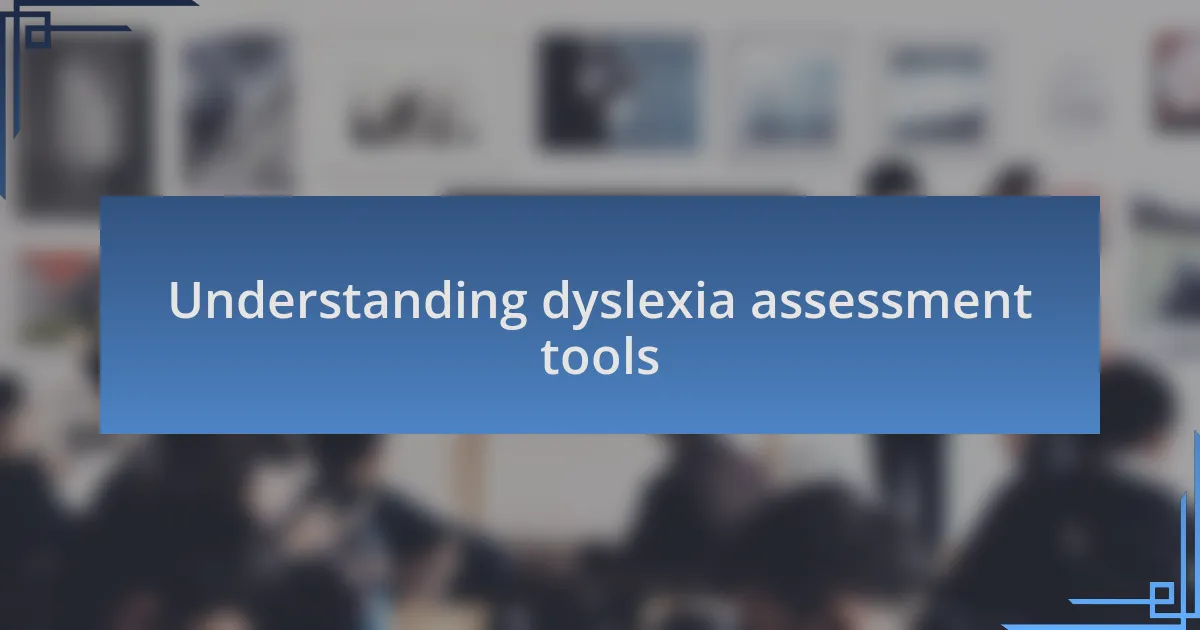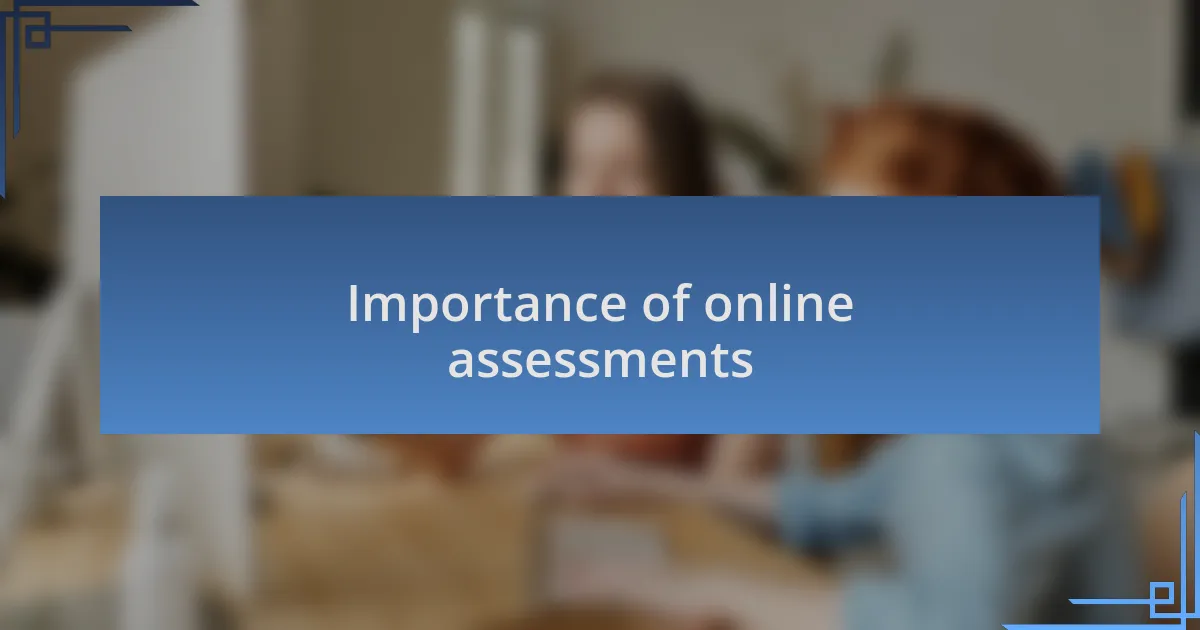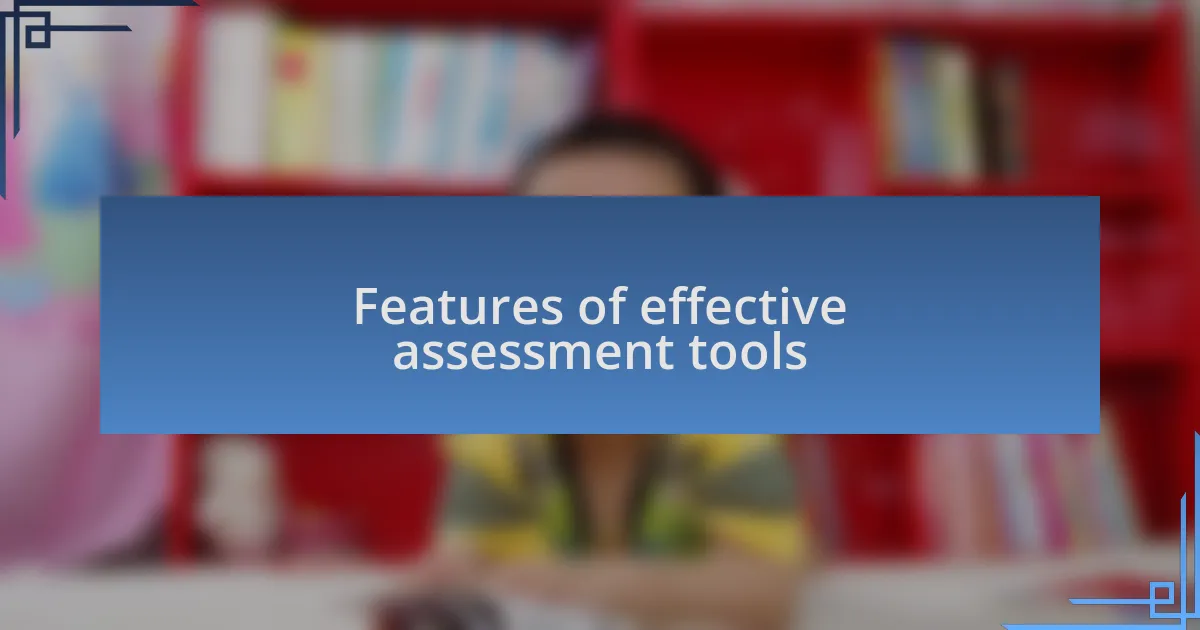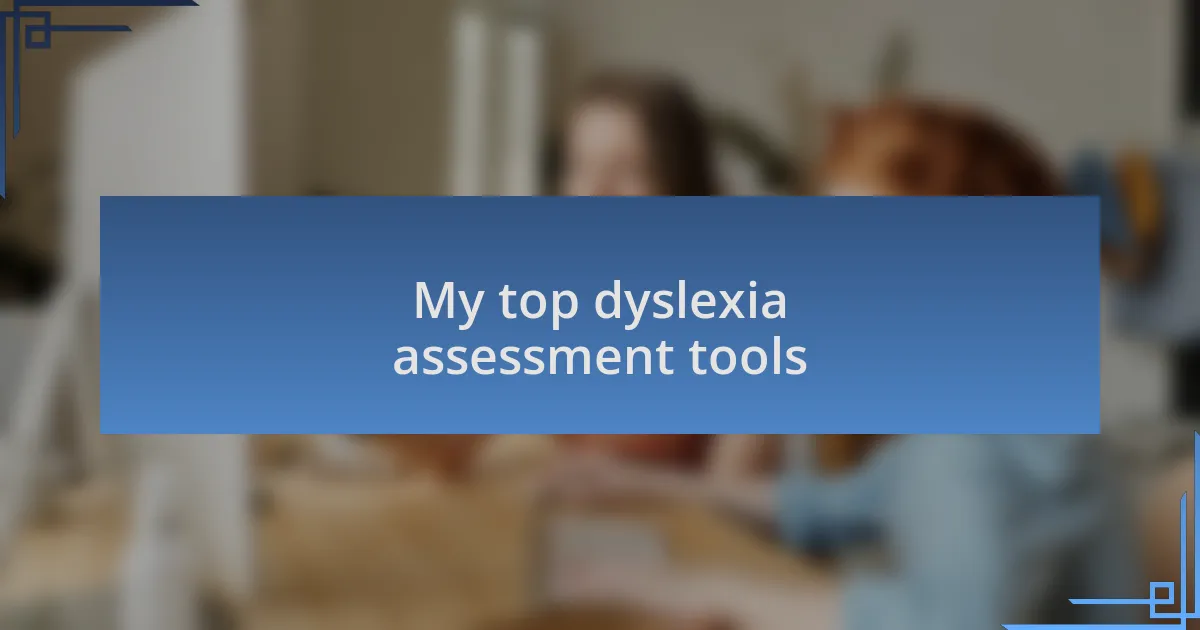Key takeaways:
- Dyslexia assessment tools are essential for early identification of learning difficulties and enable tailored interventions.
- Online assessments improve accessibility for families, providing valuable insights and fostering proactive approaches to learning.
- Effective assessment tools should be user-friendly, adaptable to individual needs, and provide comprehensive data for informed decision-making.
- Creating a comfortable assessment environment and personalizing the process enhances student engagement and accuracy of results.

Understanding dyslexia assessment tools
Dyslexia assessment tools play a crucial role in identifying learning difficulties early on. I remember watching a friend’s child struggle with reading, feeling lost in a sea of letters. It made me realize how vital these assessments are; they don’t just label a condition but pave the way for tailored interventions.
When I first learned about these tools, I was struck by their variety. Some assess phonological awareness, while others focus on reading fluency or comprehension. Have you ever wondered how a seemingly simple test could open up a world of understanding for a child? It’s powerful to think that a structured assessment can illuminate a path to better learning strategies.
These tools offer insights that are not only technical but deeply personal. For instance, I once guided a parent through an assessment that revealed her child’s unique learning profile. The relief on her face was palpable, as she finally had clarity and direction. Each assessment tool can serve as a key to unlocking potential, fostering hope and growth.

Importance of online assessments
Online assessments for dyslexia have become increasingly significant in our digital age. I recall helping a family navigate an online tool designed for quick screening, and they were astonished by how accessible and user-friendly it was. Such tools not only save time but also make it easier for parents and educators to initiate discussions, fostering a proactive approach to a child’s learning needs.
What truly stands out to me is the convenience these assessments offer. Imagine a parent in a remote area, unable to access specialized testing resources. An online assessment could provide critical insights right from their home, breaking down barriers that once seemed insurmountable. This accessibility can empower families to take action and pursue effective interventions sooner rather than later.
Moreover, the detailed feedback generated from these tools can truly transform our understanding of a child’s strengths and weaknesses. I remember reviewing results with a teacher who was amazed at how specific data could inform her instructional strategies. Have you ever seen the moment when a teacher realizes they can tailor their approach based on concrete insights? That realization can spark a shift in pedagogical methods, benefitting not just one student, but an entire classroom.

Features of effective assessment tools
Effective assessment tools should prioritize user-friendliness. I distinctly remember a time when we tested a new platform with a group of parents. Many expressed relief at how intuitive the interface was, which made them feel more confident about navigating the assessments with their children. It’s essential for tools to facilitate ease of use, allowing users to focus on understanding results rather than getting bogged down by complex navigation.
Another critical feature is adaptability. I once observed a child who struggled with traditional assessment formats but thrived in an interactive tool that adjusted to his pace and learning style. Assessments that can morph according to individual needs not only enhance engagement but also yield more accurate results. Have you ever noticed how differently people respond when they feel the tool is tailored for them?
Finally, the richness of data provided by these tools cannot be overstated. I remember analyzing a report together with a school psychologist and realizing how it unveiled patterns of strengths and weaknesses that we had overlooked. Tools that offer comprehensive insights equip educators and parents with actionable strategies, turning understanding into meaningful intervention. How often do we overlook the power of data-driven decisions in the learning journey?

Overview of popular dyslexia tools
When exploring popular dyslexia assessment tools, it’s fascinating to see how varied they are in functionality and approach. One tool I encountered not too long ago utilized engaging visual elements, making the experience feel less like a test and more like a game. This approach sparked a sense of excitement in the children taking the assessment, demonstrating the power of enjoyable interfaces in reducing anxiety and improving focus.
Another noteworthy tool I came across has a robust system for tracking progress over time. I remember working with an educator who expressed joy as we reviewed a student’s developmental journey through these assessments. Monitoring gains in reading skills often led to heartwarming celebrations in the classroom, emphasizing the importance of continuous feedback in a child’s learning environment. Isn’t it rewarding to see tangible improvements in real-time?
Then there are tools that incorporate real-world applications, allowing students to engage with content relevant to their interests. I recall discussing a particular platform with a group of parents who felt that their children’s attention was held effectively because the content resonated with them. This relevancy not only made learning enjoyable but also established a crucial connection between assessments and everyday life. How often do we overlook how contextual learning can enrich the assessment process?

My top dyslexia assessment tools
One of my top dyslexia assessment tools is the Davis Dyslexia Association program. I vividly remember using their materials during a workshop, where I noticed how dramatically engaged the participants became while using the tools. The visual and tactile elements suited those with dyslexia so well, helping them to feel more in control and less overwhelmed—almost like unlocking a secret power within themselves.
Another tool that stands out is the Lexercise program. I once worked with a student who struggled for months to make progress in reading. After just a few sessions with Lexercise, I saw their confidence soar as they tackled reading tasks with newfound enthusiasm. Observing that transformation was not just gratifying for the student but inspiring for me as well. Wouldn’t it be wonderful if every child could experience that level of success?
I also appreciate the Interactive Assessment Tool from the Dyslexia Institute. This tool’s ability to adapt to individual needs makes it incredibly effective. I recall a specific instance when I was supporting a teacher who was skeptical. After trying it, she couldn’t believe how well it pinpointed each child’s unique strengths and challenges. The excitement in her voice as she discussed the potential for tailored support truly highlighted the power of custom assessments in empowering educators and students alike.

How I use these tools
When I use the Davis Dyslexia Association program, I often find myself experimenting with different activities to see what resonates best with my students. One memorable moment was when I introduced the clay letter exercises. Watching a student mold letters from clay, I saw their stress melt away, replaced with focused determination. It’s experiences like these that remind me just how critical it is to match tools to individual learning styles.
With Lexercise, I integrate ongoing progress tracking into my sessions. One time, I set up a reward system based on the assessments they completed. Seeing the same student who once struggled suddenly light up at the prospect of earning stars for completing exercises not only reinforced their hard work but deepened our connection. Isn’t it amazing how small incentives can spark such enthusiasm and motivation?
The Interactive Assessment Tool from the Dyslexia Institute has become my go-to resource for tailoring learning plans. I vividly recall a training session where I was guided through the reporting features. Realizing that I could create comprehensive profiles that highlighted students’ trajectories was like a light bulb moment for me! It made me question how many other educators might not be leveraging such powerful insights for their teaching.

Tips for effective assessments
When conducting assessments, it’s vital to create a relaxed environment that encourages honesty and openness. I remember a particular session where I chose to conduct an assessment in a cozy corner of the library rather than a traditional classroom setting. The change in atmosphere made a significant difference; the student seemed more at ease, and I received more authentic responses. Isn’t it interesting how the right environment can influence performance?
Another essential tip is to personalize the assessment process. I often gather information about a student’s interests before starting any assessment. One time, I tailored questions around a student’s favorite video game, which not only engaged them but also allowed me to gauge their reading comprehension in a context they enjoyed. How can we expect students to perform their best if they don’t see themselves in the assessment?
Lastly, don’t shy away from follow-up discussions. After assessments, I always sit down with my students to talk about their results. This interaction allows me to clarify any misunderstandings and explore their feelings about the scores. Last week, a student revealed that they felt discouraged despite improvement, and just verbally processing that with me seemed to lift a weight off their shoulders. Have you ever considered how much impact a simple conversation can have on a student’s mindset?